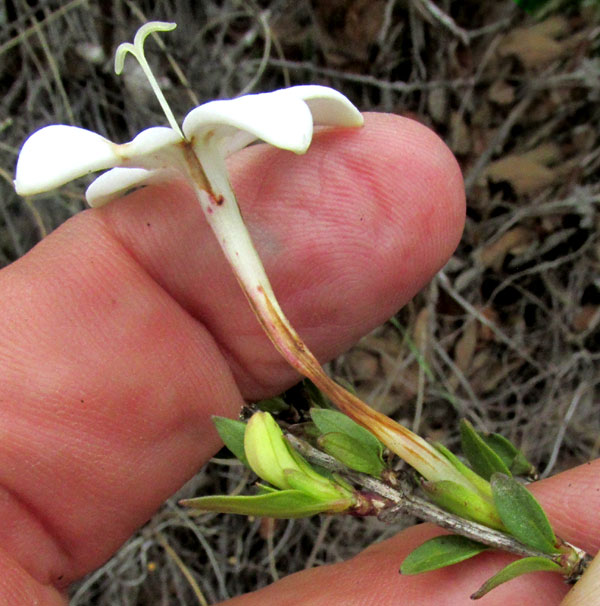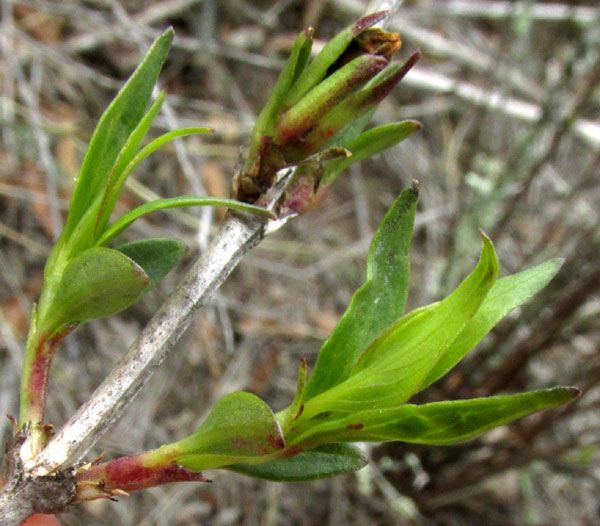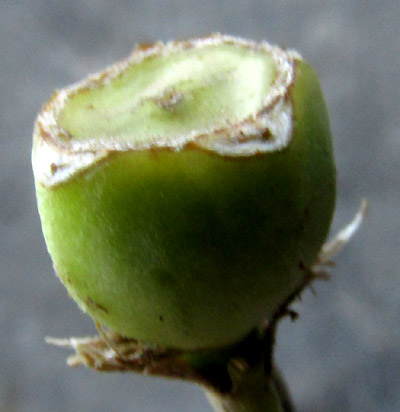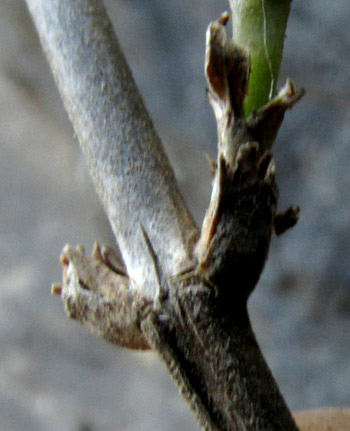Excerpts from Jim Conrad's
Naturalist Newsletter
entry from field notes dated June 28, 2022, taken in oak forest on slopes of Cerro de la Cruz, elevation ~2800m (~9200 ft), rising on the south side of the community of El Pinar, Amealco de Bonfil, Querétaro, MÉXICO, (~N20.17°, ~W100.17°)
SCENTED BOUVARDIA FLOWERING

On the chilly, droughty northern slope of Cerro de la Cruz, a much-branched shrub about a meter tall (3 ft.) with slender, stiff, brittle stems was issuing new leaves and flowers. The bush bore just one open flower, shown above my wrist. On the picture's right side, other flowers are about to open, and at the bottom numerous pale yellow, spherical flower buds are developing. Later this shrub will have lots of flowers.

The corolla was tubular, or salverform, in shape, with four corolla lobes abruptly spreading outward as shown above. A long, slender style issued from the blossom's slender throat, then divided into two stigmas, where pollen grains are expected to germinate. Pollen-producing stamens remain hidden inside the narrow tube. The corolla seems very sensitive to touch, as suggested by the brown bruises on one of the lobes. The very slender tube displayed even more bruising:

That picture shows the corolla tube rising from a yellow-green, deeply 4-lobed calyx. The snow-white blossoms are well adapted for night-flying moths with long proboscises.
The identification process was hindered by not being able to see the stamens, and my unwillingness to dissect the only open flower thereabouts. However, the stem provided important clues:

The stem is somewhat squared in cross-section, but the main features shown are that the leaves and stems arise opposite one another -- not alternating from one side of the stem to the other --and that at the bases of petioles and sideshoots there appear substantial, somewhat sharp-pointed, scale-like stipules. When you see stems with opposite leaves and such prominent stipules, think "the Coffee/Madder Family, the Rubiacea."
With that insight, eventually it could be figured out that here we have what's sometimes called the Scented Bouvardia, BOUVARDIA LONGIFLORA, endemic just to oak-pine and oak forests from north-central Mexico south into Guatemala, at elevations between 500-3000 meters (1600-9850 ft). Our plant is near its high-elevation limit. In fact, once I worked into the valley below, many more Scented Bouvardia's appeared, in full flower. However, I like this one, maybe struggling a bit with the chilly nights, as I did.
That name Scented Bouvardia is just one of several English names, since the species is much planted in gardens and marketed worldwide. In fact, cultivars have been created from this Mexican species, including a stubby "French Bouvardia" with large green leaves and thick clusters of white flowers, good for pot planting. The species is especially liked because of its flower's fragrance, similar to that of honey or jasmine, which is another good adaptation for attracting nocturnal moths. Some cultivars produce flowers in different hues of red and rose.
In Spanish our bush is known as Flor de San Juan because it flowers at the beginning of the rainy season -- which hasn't come this year -- which coincides with festivities celebrating San Juan Bautista, John the Baptist.
Several ethnobotanical works list the species' flowers as edible, with no further details. I suspect the real use was to soak the flowers in water, add sugar or honey, and have perfumy drink, something I've seen done with various blossoms with an odor like jasmine odor.
Entry from field notes dated July 1, 2023, taken along small gravel road between El Suspir and Curva de la Doctorcilla, about 1 straight-line km north of El Doctor; in mountains of east-central Querétaro state, municipality of Cadereyta de Montes, 12 straight-line kms due east of Vizarrón de Montes but much farther by twisting roads; elevation ~2600m (~8500 ft), Querétaro, MÉXICO, (N20.85563°, W99.58686°)
SCENTED BOUVARDIA WITH IMMATURE FRUITS
 The practically leafless, knee-high shrub at the right grew at the base of limestone outcrop on a steep, shaded slope. It caught my attention because it bore several immature fruits, one of which is shown below:
The practically leafless, knee-high shrub at the right grew at the base of limestone outcrop on a steep, shaded slope. It caught my attention because it bore several immature fruits, one of which is shown below:


Atop the above fruit there are scars from four sepals. At the right, a broken-open fruit shows that it's divided into two compartments, or carpels.  On the plant photographed previously, the stipules weren't well shown, so at the left you can see that they're long and slender.
On the plant photographed previously, the stipules weren't well shown, so at the left you can see that they're long and slender.